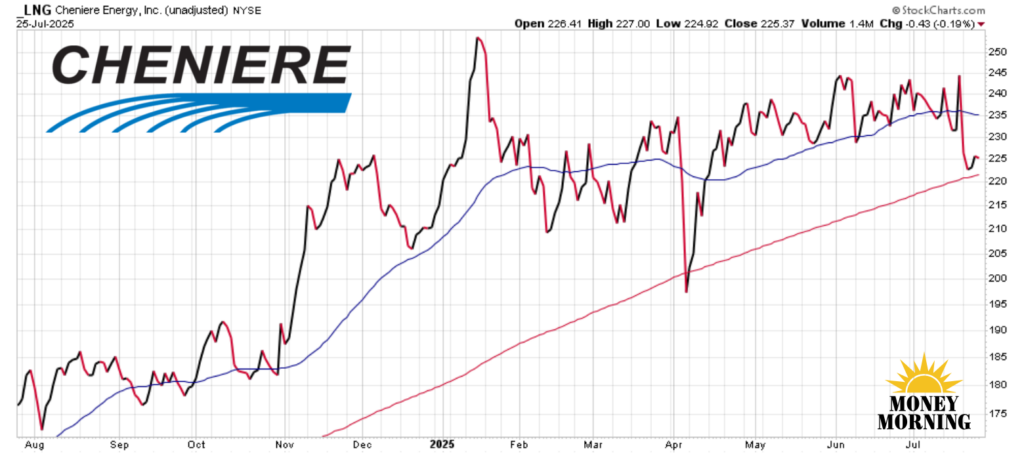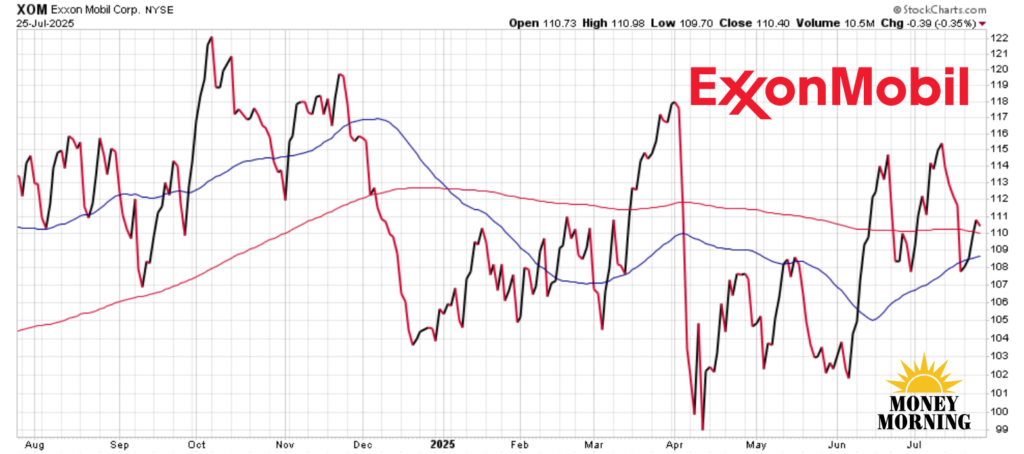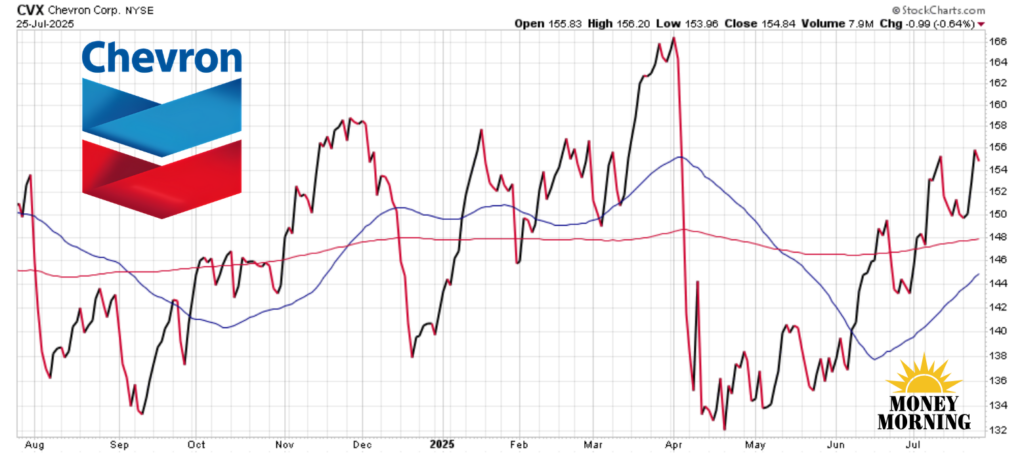President Trump announced a landmark U.S.-EU trade deal yesterday, a pivotal move to reshape transatlantic commerce and bolster U.S. energy exports. The agreement includes a 15% tariff on most EU goods, significantly lower than the threatened 30%, and secures $750 billion in U.S. energy purchases, with a heavy emphasis on liquefied natural gas (LNG), oil, and nuclear to reduce Europe’s reliance on Russian energy.
Additionally, the EU committed to $600 billion in investments, targeting technology, manufacturing, and energy infrastructure. The deal is a significant geopolitical weapon that positions the U.S. as a dominant energy supplier to Europe.
While the agreement spans multiple sectors, its energy focus creates significant tailwinds for U.S. energy companies. Three stocks in particular stand to benefit substantially from this transformative deal.
Cheniere Energy (LNG)
Cheniere Energy (LNG), the largest U.S. LNG exporter, is the most direct beneficiary of the EU’s $750 billion energy purchase commitment, particularly the $250 billion annual pledge for U.S. LNG.
Europe’s urgent need to replace Russian gas aligns perfectly with Cheniere’s robust infrastructure, including its Sabine Pass and Corpus Christi terminals. The company’s long-term contracts ensure stable revenue, and its ongoing Corpus Christi Stage 3 expansion will increase export capacity, meeting rising European demand.
 Because of Cheniere’s market dominance in LNG exports, it is the most obvious winner from the deal. Analysts, including Michael Brown from Pepperstone, emphasize that the deal’s structure favors LNG exporters, as Europe seeks reliable, non-Russian energy sources. While global LNG price volatility poses a risk, Cheniere’s scale and contractual stability make it a top pick for investors seeking exposure to the deal’s energy tailwinds.
Because of Cheniere’s market dominance in LNG exports, it is the most obvious winner from the deal. Analysts, including Michael Brown from Pepperstone, emphasize that the deal’s structure favors LNG exporters, as Europe seeks reliable, non-Russian energy sources. While global LNG price volatility poses a risk, Cheniere’s scale and contractual stability make it a top pick for investors seeking exposure to the deal’s energy tailwinds.
ExxonMobil (XOM)
ExxonMobil (XOM) is the leading integrated oil and gas company and is also well-positioned to capitalize on the EU’s energy purchase commitments, which include oil and natural gas alongside LNG. With its global production capacity and growing LNG portfolio, Exxon can meet Europe’s demand for diverse energy sources.
 The company’s scale allows it to absorb potential cost increases from steel tariffs, a concern noted by Wood Mackenzie, better than smaller competitors. What stands out most for XOM from the deal is its geopolitical leverage and ability to scale production, while its resilience in volatile markets makes it a standout choice.
The company’s scale allows it to absorb potential cost increases from steel tariffs, a concern noted by Wood Mackenzie, better than smaller competitors. What stands out most for XOM from the deal is its geopolitical leverage and ability to scale production, while its resilience in volatile markets makes it a standout choice.
Analysts see Exxon as a core beneficiary, given its ability to ramp up exports to Europe while maintaining profitability. Although global oil price fluctuations could impact short-term gains, the energy titan’s diversified operations and strong balance sheet make it a compelling choice for long-term investors.
Chevron (CVX)
Similar to Exxon, Chevron (CVX) is another integrated energy giant that stands to profit handsomely from the EU’s $750 billion energy pledge, particularly in oil and LNG exports. Its recent victory over Exxon in a dispute over Hess’s offshore oil assets in Guyana enhances its growth outlook, complementing the trade deal’s opportunities.
 Chevron’s production capacity and global reach make it a clear winner alongside Exxon, and pairing CVX with XOM is a smart investment strategy. Analysts note that Chevron’s diversified portfolio mitigates risks from tariff-related cost increases, and its LNG projects position it to capture Europe’s growing demand.
Chevron’s production capacity and global reach make it a clear winner alongside Exxon, and pairing CVX with XOM is a smart investment strategy. Analysts note that Chevron’s diversified portfolio mitigates risks from tariff-related cost increases, and its LNG projects position it to capture Europe’s growing demand.
While less focused on LNG than Cheniere, Chevron’s ability to supply both oil and gas aligns with the deal’s broad energy focus. There is always the potential for negotiations to falter as the nitty gritty details are hammered out, but Chevron’s operational strength and strategic assets make it a strong contender for deal-driven growth.
The Bottom Line
The U.S.-EU trade deal is a major win for the energy sector, particularly for companies like Cheniere Energy, ExxonMobil, and Chevron, which are poised to capitalize on Europe’s shift away from Russian energy. Cheniere’s LNG dominance, ExxonMobil’s global scale, and Chevron’s diversified portfolio position them as exceptional beneficiaries and stock to buy.
However, risks remain. Steel tariffs could raise operational costs, particularly for smaller players, though large-cap firms are better equipped to manage. The EU’s $750 billion energy purchase and $600 billion investment pledges are spread over years, and failure to follow through could limit upside. Global energy price volatility and potential EU regulatory hurdles, especially on environmental policies, may also impact performance.
Despite these challenges, the deal’s energy focus creates a compelling case for investing in these three stocks, provided investors stay vigilant about market and geopolitical developments.
— Chris Johnson
Out of 23,281 Stocks... Only ONE is This Profitable and Undervalued. [sponsor]$3 billion+ in operating income. Market cap under $8 billion. 15% revenue growth. 20% dividend growth. No other American stock but ONE can meet these criteria... here's why Donald Trump publicly backed it on Truth Social. See His Breakdown of the Seven Stocks You Should Own Here.
Source: Money Morning
